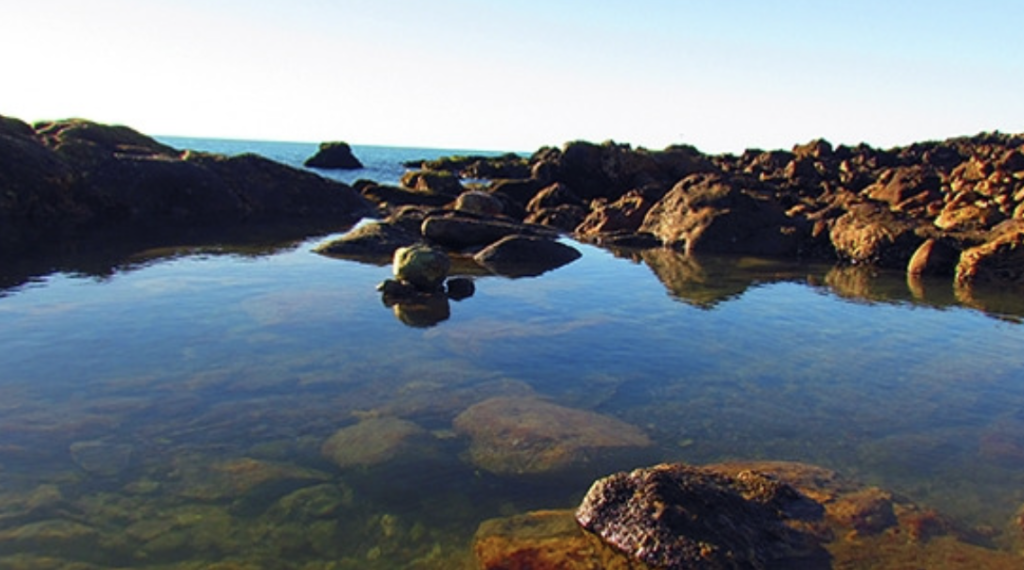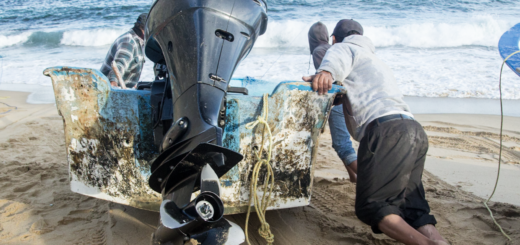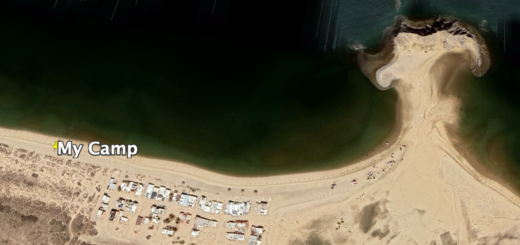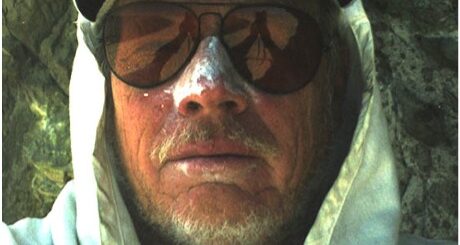Kayaking Sea of Cortez: The North Wind – Day 5
I woke up on the beach at the north end of Puertecitos at about 5:00 AM and started packing my new supplies. There was a north wind as I put into the water at about 6:00. The wind was blowing about 10 miles an hour from my back as I headed south along the shore of the Sea of Cortez. This would be my first chance to use the sail that I had wrapped and stored under the bungee cords on my forward deck. The sail is a “V” shaped rig that only works well when moving downwind. I put it up and almost immediately was moving about as quickly as I could paddle along the rocky coast with Puertecitos slowly passing to my right. I brought the sail because I thought it would give me some relief from continuous paddling, and that seemed to be working.

As I proceeded along the coast of the peninsula, I passed some hot springs where a family was bathing in steaming water between the rocks. These hot springs, called the Aguas Termales of Puertecitos, are natural hot springs filled with water rich in minerals rising up through the rocks. There are several thermal pools filled with extremely hot water but are cooled to inviting temperatures thanks to the Sea of Cortez’s influx of cool salty water during high tide.
I got to the southern end of the peninsula and turning west toward the shore I dropped the sail and crossed the bay at the mouth of the harbor at the main part of Puertecitos. When I got to the western shore the wind was again from my back, so I put the sail up again. I moved quickly along the shore where there were large black cliffs and rocks made of lava at the water’s edge. At about 7:00 AM the wind and waves continued to rise so that I had to cradle the paddle up in my arms while holding the poles of the sail so the paddle wouldn’t catch the waves that were passing by the kayak. As I sped downwind I steered with my feet on the pedals connected to the rudder. As the wind built up strength I was beginning to wonder if this wasn’t one of those legendary north winds. At about this time I noticed that one of the shrimp boats that had been working offshore was headed into Puertecitos Bay. Soon the wind strengthened, and steering became very tricky and, as I got farther south from Puertecitos, there were more waves building. I dropped the sail and secured it to the deck and started paddling. Offshore I saw a second shrimp boat coming in to anchor in the harbor at Puertecitos. This can’t be a good sign, I wondered if they were getting ready for a storm.
The winds are most complex in the northern end of the Sea of Cortez, where they are sucked in by an almost constant low pressure, especially blowing from the west, north and northeast. When the north winds come they may last for three or more days, especially during March and early April. The north winds can develop into a hurricane force and reach as far down south as Guaymas on the Mexican mainland. Apparently, the entire fishing fleet based in San Felipe was destroyed in a storm some years ago. Other strong winds can blow across the peninsula from the Pacific Ocean. These Pacific origin storms bring little or no rain but blast down the lengthy arroyos, especially near Bahia San Luis Gonzaga (Gonzaga Bay) and Bahia de Los Angeles, both of which I would be crossing in the days and weeks ahead.
Worried about the wind that seemed to be increasing in force, I started looking for safe spot to land, but there were no beaches that had much sand, just large boulders or rocky shelfs. Finally, I had to settle on a rocky beach with a little sand and some gravel along a narrow shoreline. It was only 7:30 in the morning and I had only gone about 3 miles, but the rising wind would let me go no further. The cove was surrounded by slate-like rocks, no sand anywhere. This cove was on the outskirts of the southern end of Puertecitos and there were a few houses barely visible on the cliffs above.
After landing, I climbed up on some rocks to look out over the Sea of Cortez and I could see white caps in the distance. It looked like it was going to blow, so I decided to make myself comfortable. I pulled the kayak up across the rocks and down the beach about 40 yards to a level spot that I thought would be above the high tide line. Fortunately, the rocks on the beach where derived from the slate material so they were flat and did not do a lot of damage to the bottom of the kayak. High tide was going to be at 11:30 am, so I had a considerable distance to haul the kayak before I felt safely above the tide and waves. To reduce the damage from the scraping the rocks, I collected driftwood to lay in front of the kayak as I pulled it across the rock surface.
The wind continued building and soon there were four shrimp boats in the harbor at Puertecitos about 2 miles north of this cove. I guessed the wind was going to last awhile and these shrimp boats did not want to be caught at sea in that weather.
Too bad this cove was not more remote, because I felt confined by some houses that were on the cliff above the cove. With the high winds funneling through the cove it was fascinating to watch the pelicans fly across the cove and down the beach. They came soaring in over a cliff and swooped down right in front of my tent. In one group there were 31 pelicans in one line, truly majestic!
I fell asleep in the tent until about 2:30. The wind had dropped a bit and I saw one of the shrimp boats pick up its anchor and go south. But the wind was still too strong for me so it began to look like I would be stuck here for the night. The tide was dropping and when I looked at the tide charts I discovered that for the period covered by my trip it was usually low tide in the morning and was also low tide in the evening, making it difficult to launch or land without dragging the kayak a long way up the beach to be safe from the high tide.
The last two shrimp boats pulled up their anchors and went out at about 5:15 PM, so I thought we would have better weather tomorrow. The boats were fairly large, I would judge 80 or 90 feet long, and were called “Titan” and “Coloso”. Someone later told me about the habits of these shrimp boats. I learned that they normally come in during the day and let the crew sleep. Then they go out in the evening and fish all night. So their coming and going from the harbor probably had very little to do with the weather. Late in the afternoon I saw two shrimp boats working just offshore. Once they get their nets down they move along at about two or three knots. They were in nice condition and looked fairly new. Later I learned that most of the fleet from San Felipe was new because it was replaced by these new boats after the whole fleet was lost after being struck by a disastrous storm.
While stuck in this cove because of the weather, I did some exploring and found the geology here was just awesome. There were lava flows and lava mushrooms and, in one place the volcanic cooling resulted in a large circular structure about 60-70 ft. in diameter in the lava rock. The circular structure was composed of inch thick slate-like plates about 10 inches wide. The lava rocks also formed wonderful tide pools.
Next: Day 6 – Passing the Vulcan Prieto
Please comment on Two Miles to the Horizon
Back to the beginning of Two Miles to the Horizon







2 Responses
[…] Chapter II. Puertecitos to Gonzaga Bay – The North […]
[…] Day 5 – The North Wind […]